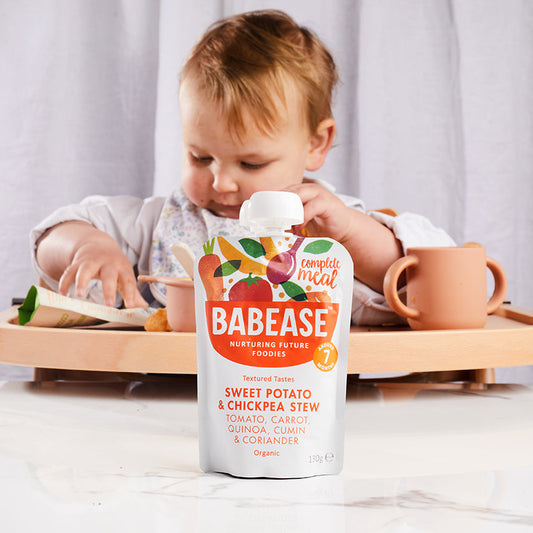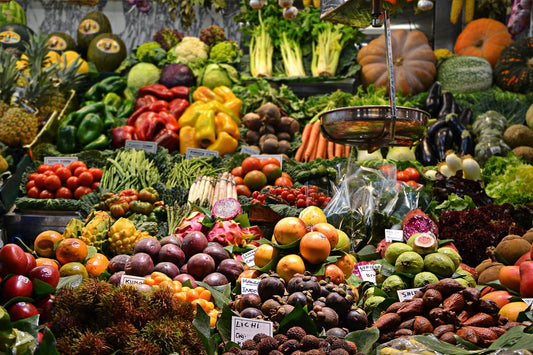THE WEANING STAGES EXPLAINED
Stage 1 Weaning: 6-7 months: Getting weaning started:
The first few weeks of weaning, sometimes referred to as stage one, is when your baby will begin to explore solid foods for the very first time. This is when you might introduce new flavours, with a focus on bitter and savoury vegetables, smooth textures or soft finger foods.
Weaning is a very gradual process and stage one will start slowly at first. Begin with 1 meal a day at a time that suits you and your baby. How much food your baby accepts is not important during this stage. Focus on exposing your little one to new flavours and textures and allow them to explore foods and practice the complex skills needed to eat.
Once your baby has been exposed to a variety of vegetables you can begin to include foods from other food groups one at a time such as beans, pulses, meats, fish, eggs, potatoes, rice, pasta, bread, other grains, fruits and dairy foods.
Milk feeds don’t reduce yet and the majority of your little one’s nutrition and energy will still come from their milk (breast or formula) so keep up with you baby’s usual milk feeding routine alongside their solid food.
As your baby begins to adapt to solid food and eats a little more at mealtimes, you might like to introduce a second meal each day. This could happen sometime between 6 and 7 months. Every baby is different so let your baby guide you.
Stage 2 Weaning: 7-9 months: Exploring Flavours and Textures
Sometimes referred to as stage 2 weaning, this is the stage when your baby begins to explore more combinations of ingredients, flavours and textures. Babies are becoming mini food explorers and will move on, from meals with just a few single ingredients, to enjoy a wider variety of foods, flavours and nutrients. Continue to combine foods from the 4 main food groups: vegetables & fruits; carbohydrate foods; beans, eggs, meat, fish; and dairy foods.
The texture of your little one’s food might also become a bit more challenging with the inclusion of soft lumpy, mashed foods and more and more finger foods. Progressing with textures as well as flavours and food combinations will help your baby to advance their feeding skills and learn how to manage lumpy foods in their mouth.
Around 7-9 months your baby can gradually move on to 3 meals a day. Every baby is different and will progress on to 3 meals at different times. Your baby might be ready for 3 meals when they are;
- Readily accepting 2 meals a day.
- Taking larger quantities of food.
- Appear to enjoy mealtimes and exploring their food.
Guage how your baby is responding to solid food and move them on to 3 meals a day when you feel they are ready to accept it.
As the quantity of food increases you may find that your baby takes a little less milk. Allow your baby to guide this process. It’s a good idea to continue to offer milk feeds on demand in between the meals at this age. Your baby is growing and developing rapidly and a mixture of milk feeds and solid foods will support their growth.
If your baby is not interested in the foods you’re offering, don’t worry. Repeat the foods a few days later and remember that food refusal is normal. Studies demonstrate that offering a food 16 times or more is necessary before children will try them. Perseverance pays of so don’t give up and remember that even if your baby doesn’t eat the food, they will still benefit from touching, smelling and playing with their food. Eating together, smiling and making eye contact with your baby are also great ways to make mealtimes relaxed and enjoyable for your little one.
Stage 3 Weaning: 10-12 months: Preparing for family foods:
Around 10-12 months, sometimes referred to as stage 3 weaning, is when your baby is probably used to having 3 meals a day and solid food is becoming a more dominant part of their diet. You might start to introduce a wider variety of foods, textures, finger foods and progress on to some family foods too.
The texture of food continues to progress throughout this stage too. Moving on from soft mashed foods to coarser textures which require more chewing and chomping is a great way to advance your little ones feeding skills. Offering a wider variety of finger foods will also give your little one the chance to practice biting and chewing and will help to desensitise your baby’s mouth to lumps.
When your baby is established on 3 meals a day you may notice that milk feeds take more of a back seat. The age at which babies drop milk feeds varies widely and depends on how they are adapting to solid food. Think of milk feeds as an important snack in between meals and a chance to top up on energy and nutrients but food is likely to provide a good proportion of your baby’s energy and nutrient intake now.
As with stage 2 weaning, continue to combine foods from different food groups and explore a wide variety of ingredients and flavours. Variety is a wonderful thing during weaning and including variety of foods, flavours and colours in your little one’s diet will not only increase their familiarity of foods but will also provide a wide variety of nutrients.
Your baby will learn a lot from watching you and others eat. Including them at mealtimes as much as possible is a great way to make mealtimes a sociable and enjoyable occasion. Your baby can join in with your family meals and may even like to try some of your home cooked family foods just be sure to avoid any added salt and sugar.
GET 20% OFF YOUR FIRST ORDER!
Join the Baby Club for FREE weaning help and advice.


